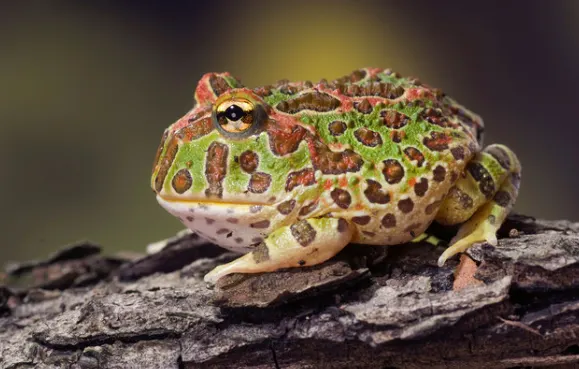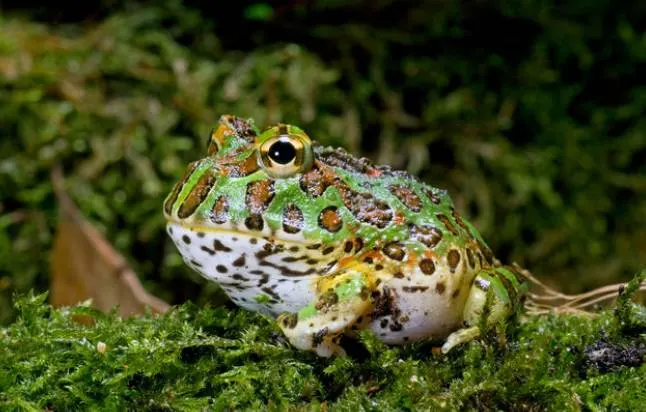The Argentine Horned Frog, scientifically known as Ceratophrys Ornata, is a captivating amphibian native to South America. Also referred to as the Pacman frog due to its resemblance to the video game character with a wide, snapping mouth, this frog is a popular choice for exotic pet enthusiasts. Known for its unique appearance and intriguing behavior, the Argentine Horned Frog has captured the interest of many. Here, we explore its classification, physical characteristics, behavior, diet, habitat, and conservation status.
Table of Contents
Classification and Physical Characteristics
Scientific Classification
- Kingdom: Animalia
- Phylum: Chordata
- Class: Amphibia
- Order: Anura
- Family: Leptodactylidae
- Genus: Ceratophrys
- Scientific Name: Ceratophrys Ornata

Physical Traits
Argentine Horned Frogs are known for their striking camouflage, which includes combinations of greens, yellows, browns, and reds. Males typically grow to about 4.5 inches, while females can reach up to 6.5 inches. These frogs have squat, round bodies and short legs, distinguishing them from other frog species. Their distinctive horns are actually folds of skin above their eyes, aiding in camouflage.
Behavior and Lifestyle
Argentine Horned Frogs are solitary and ambush predators. They have a unique hunting strategy, patiently waiting for prey to come close before leaping to capture it with their wide mouths. Despite their aggressive hunting techniques, these frogs are not skilled jumpers due to their short legs.
One of their most fascinating behaviors is their ability to enter a state of apparent death to survive dry conditions. If their environment becomes too dry, they form a resilient outer layer of skin and remain motionless until rehydrated, at which point they shed the outer skin and ingest it.
Habitat and Diet
Habitat
In the wild, Argentine Horned Frogs thrive in the humid, muddy forest floors of South American rainforests and tropical swamplands. They spend much of their time buried in damp soil or leaf debris to maintain moisture.
For those keeping them as pets, it is essential to replicate their natural habitat by using moist peat moss, damp soil, or grated pine bark mulch in their enclosures. The enclosure should maintain a temperature of around 82°F during the day and slightly cooler at night.
Diet
In their natural habitat, these frogs consume a variety of prey, including mice, insects, amphibians, and even other frogs. As pets, they can be fed a diet of crickets, worms, and occasional mice. However, due to their low activity levels, it’s important to avoid overfeeding, particularly with high-fat foods like mice.
Predators and Threats
Argentine Horned Frogs face threats from predators such as snakes, birds, and bears. Their population is also impacted by habitat destruction and pollution. While currently listed as “Least Concern” by conservation status, they are approaching a near-threatened status due to these environmental pressures.

Reproduction and Lifespan
During the mating season, these frogs leave their burrows to find mates. Females lay approximately 2,000 eggs in a suitable water source. The eggs hatch into tadpoles within two weeks, and these tadpoles mature into frogs in about a month. In the wild, Argentine Horned Frogs live for about 5 to 8 years, but in captivity, they can live up to 15 years.
7 interesting facts about the Argentine Horned Frog
- Huge Appetite: Argentine horned frogs can try to eat prey larger than themselves, sometimes suffocating in the process.
- Sexual Dimorphism: Female horned frogs are generally larger than their male counterparts.
- Longevity in Captivity: While they live for 5-8 years in the wild, they can live up to 16 years when kept as pets.
- Low Maintenance: These frogs are popular as pets due to their low maintenance requirements.
- Camouflage Experts: Their colors and patterns help them blend seamlessly into their surroundings, making them excellent ambush predators.
- Cannibalistic Tadpoles: As tadpoles, they are entirely carnivorous and may even eat each other.
- Misunderstood Creatures: In Argentina, they have been mistakenly labeled “horse killers” due to their tendency to grasp onto the lips of grazing horses.
The Argentine Horned Frog is a remarkable amphibian with unique adaptations and behaviors. From its distinctive appearance to its fascinating hunting strategies, it continues to intrigue both scientists and pet owners alike. However, with environmental changes posing threats to its habitat, efforts in conservation and responsible pet ownership are essential to ensure this species thrives for generations to come.
- Enchi Ball Python: A Unique and Stunning Morph of Python regius - March 27, 2025
- Emerald Tree Monitor: The Enigmatic Green Guardian of the Rainforest - March 26, 2025
- The Egyptian Cobra (Naja haje): A Fascinating Serpent - March 25, 2025
